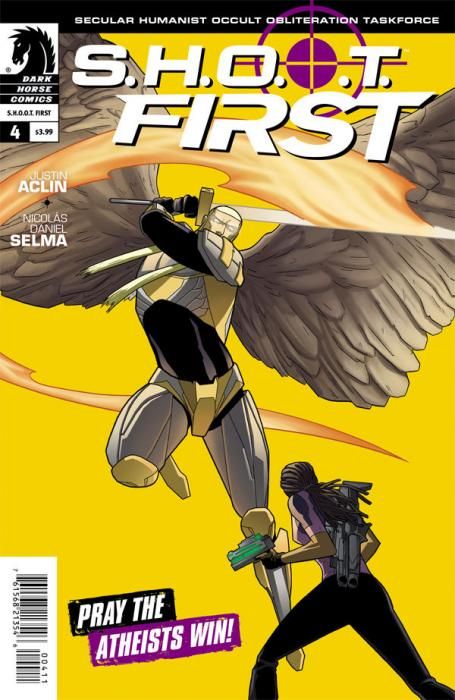The finale of "S.H.O.O.T First" (at least until the team returns in "Dark Horse Presents" in March) is buoyed by great concepts but bogged down by subpar execution. It's clear that the creative team has a lot of ideas, but they'd have been better served by not cramming them all into this last issue. The plot points fire so quickly, and with so little lead-in from the previous issues, that a lot of the extra information fails to make any dramatic impact. To be fair, they are trying to fit their arcs into a scant four issues -- but when they just dropped so many reveals in my lap, I ended up not caring about quite a few of them. And if the reader isn't going to care, why rush to get it in?
However, those arcs in which they had invested -- namely, Mrs. Brookstone's -- did pay off nicely. When she finally tells her son what she really believes about the afterlife, it's stirring and highly satisfying. It was also refreshing to see an atheist unabashedly and passionately defend her views, rather than apologetically explain them (since the latter scenario is so much more prevalent in mass media). This series presents atheism as a celebration of a certain set of values, rather than merely a repudiation of religion's values. The positivism makes the secular themes feel less like a tired attempt at blasphemy and more like a modern affirmation of nonbelievers and the awesome things they can achieve.
Aside from the themes, however, "S.H.O.O.T First" can feel pretty stiff. The secondary characters don't feel real, and a lot of narrative space is wasted on subplots that will never be fleshed out. For instance, the big reveal that Seth has been hiding information from the rest of the team is not impactful. The team's eventual split into two groups is not explained. While these do give the series a sense of closure, they don't necessarily add anything for the reader except for more questions. However, my pet peeve of the characterization has to be Byron's accent. It is aggressively awful, with almost every line peppered with a stereotypical British-ism. Less would have been so much more.
Sentra's art does not help with the stiffness. He often draws human bodies in posed, unnatural positions that feel more awkward than active. The coloring also flattens all the characters' faces so that expressions which might have otherwise been clear are unreadable. Still, some scenes are very well-done, and he has certainly improved over the course of the series. When the angel and Cal attack, they feel appropriately enormous, and their faces are readable and coldly determined. Sentra and Selma also use silhouettes to quite cool effect, both when the team is fleeing and when one of the folklorists is killed.
In sum, despite my criticisms, it's not as if this were irredeemable. The ideas are still fun and clever, the lead characters show sparks, and the whole project was clearly done with a lot of love. However, even with all these first-rate qualities, S.H.O.O.T First remains better in concept than in execution.

